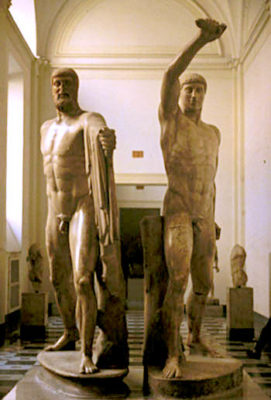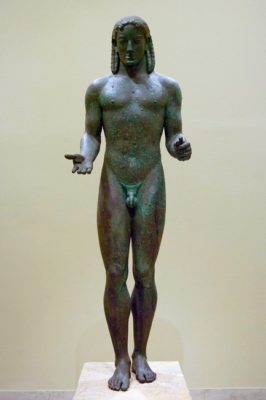Sculpture of a man in Ancient Greece art
Author:
Material:
Location:
Fine art from past murals in prehistoric times to abstract forms of modernity expresses the peculiarities of human perception of the world. Whether it is an image of an animal, a sculpture of a woman or a sculpture of a man, it is an expression of ideas about beauty, about ideas in the form or on the plane.
The image of men most often glorified the beauty of the heroic deeds of the heroes, imprinted in stone the greatest thinkers and spiritual mentors.
The sculpture of a man in the Archaic period of Greece dates from the 7th-6th centuries BC and was marked by mass images of kuros. These famous sculptures of young Greeks with a distinctive spiritualizing smile and with more precise proportions of the human body are attractive with their beauty and restraint. It was during this period of the formation of sculpture as a separate type of art – the idol was transformed into a concrete image of a person.
Lightness and cheerfulness is distinguished by the work of the ancient masters of Greece. The most famous antique sculpture of men “Apollo Shadow” was created around 550 years. BC. The ancient Greek word “kuros” was called a young man, a young soldier. Greek sculpture of a man of this period is distinguished by compositional frontality and standard posture: young heroes stand upright, slender, walking forward (with left leg extended), arms lowered along the body – extended, pressed to the hips, fingers – bent.
The monumental sculpture of this time is represented by the heroes of myths of ancient Greece. In the temple of Artemis (around 590 BC), relief compositions dynamically reveal the plot of the famous myth of Medusa-Gorgon and Perseus.
The antique man sculpture from the composition “Kuros from Piraeus” of Athens is remembered by beautiful more elaborate facial features and sustained body proportions.
The sculpture of a man of this period is symmetrical, the masters of sculpture of Greece tried to achieve a perfect fit of body parts. Such is the sculpture of the man “Critius Boy” was created during the first Greek-Persian war around 480. BC e. The work demonstrates not approximate, but mathematical calculations in the image of the proportions of the human body.
By the end of the VI century. decreases the number of orders for the image of tombstones of young men. Greek sculpture such as kuros loses its relevance and a transition is made to the image of real people. Among the examples of the early period is a sculpture of a man from the composition “Garmody and Aristogiton” (c. 500 BC). Despite the preserved features of the formalities of kuros, the sculptures become much more lifelike. This memorial was erected in Athens as a symbol of democracy and served as an example of a departure from the iconographic depiction of kuros and at the same time a change in the aristocratic system.
The Greek man sculpture “The Horseman of Rampin” and the stela of Aristion was created around 500 BC. resolved quite constrainedly, but the exact transfer of body plastic and internal dynamics symbolizes the transition of art to more significant achievements in the period of classics.







